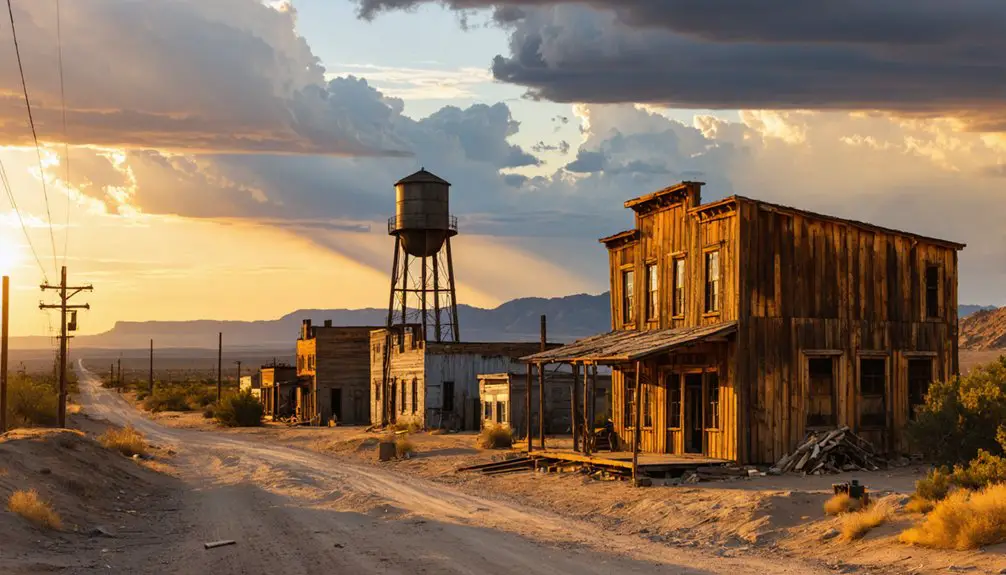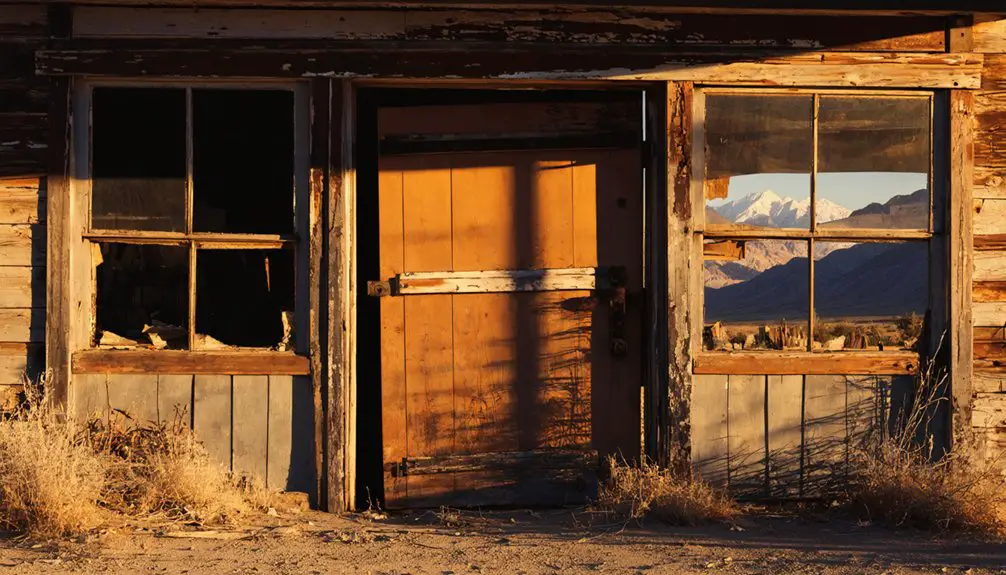You’ll discover Miller’s Ghost Town in Nevada’s mining country, established in 1904 as an essential railroad hub and milling center. Originally called Desert Wells Station, it served stagecoaches before evolving into a bustling community of 274 residents by 1910. The town supported regional mining operations with two major mills and extensive railroad facilities until 1947. Today, its remnants offer dark sky viewing while preserving traces of Nevada’s industrial heritage.
Key Takeaways
- Miller’s Ghost Town began as Desert Wells Station in 1866, later becoming a vital railroad hub named after Delaware governor Charles R. Miller.
- The town flourished with mining and railroad operations, reaching a peak population of 274 residents by 1910.
- Two major mills operated in Miller’s: the 100-stamp Desert Power facility and 60-stamp Tonopah-Belmont mill for ore processing.
- The town declined after 1910 when railroad shops moved to Goldfield, with final abandonment occurring after railroad operations ceased in 1947.
- Today, Miller’s is a popular dark sky viewing location with historical markers highlighting Nevada’s mining heritage.
From Desert Wells to Miller’s: A Town’s Origins

Two significant transportation eras shaped the origins of Miller’s Ghost Town in Nevada’s desert landscape.
The site first emerged as Desert Wells Station around 1866, serving as an essential water source for stagecoaches traversing the harsh terrain between San Antonio and Silverpeak. You’ll find that this desert oasis proved crucial for travelers and freight movement along the Silver Peak route, later extending its service to the Sodaville-Tonopah road after 1901.
Desert Wells Station provided vital water and respite for stagecoaches braving Nevada’s unforgiving desert between San Antonio and Silverpeak.
The arrival of the Tonopah and Goldfield Railroad in 1904 transformed the settlement’s identity. The town grew significantly with the construction of a 100-stamp mill in 1906. By 1910, the bustling community reached a population of 274 as mining and railroad operations flourished.
Named after Charles R. Miller, a railroad director and former Delaware governor, the town shifted from a simple watering hole to a key railroad station. This evolution marked the region’s shift from stagecoach transportation to industrial rail service, setting the stage for Miller’s future growth.
The Bustling Days of Rails and Mills
You’d find Millers at its peak operating as a crucial junction where the Tonopah & Goldfield Railroad‘s extensive maintenance facilities, including a massive roundhouse and turntable, supported the region’s mining operations.
The town’s economic engine roared with two substantial mills – the 100-stamp Desert Power facility and the 60-stamp Tonopah-Belmont operation – processing precious ore from the surrounding boom camps.
These industrial powerhouses drew a population of nearly 275 residents by 1910, creating a vibrant community complete with a business district, post office, and even a baseball diamond that hosted spirited local matches. By the 1920s, ore production declined significantly, leading to the gradual abandonment of the railroad facilities and the town itself.
Railroad Hub Operations
At the heart of Miller’s early success stood a critical railroad hub that transformed a simple desert watering stop into an essential transportation nexus.
You’ll find evidence of its logistical significance in the massive repair shops built in 1907, where skilled workers maintained the rolling stock that kept the mining region’s lifeblood flowing.
The hub’s railroad maintenance facilities included a roundhouse and turntable, supporting locomotive servicing for the bustling Tonopah & Goldfield Railroad.
The town’s strategic position, just 10 miles west of Tonopah, made it the perfect spot for connecting multiple mining camps.
You can imagine the constant activity as trains loaded with precious ore rumbled through, while ambitious plans were laid for expanding rail lines as far as Austin, though these dreams would ultimately remain unfulfilled.
Mill Processing Economic Impact
When the Tonopah Mining Company established its massive 100-stamp cyanide mill in 1906, Millers transformed into a powerhouse of ore processing that would shape the region’s economic destiny.
You’d have witnessed the town’s rapid expansion as the Tonopah-Belmont Development Company added another 60-stamp mill the following year, creating specialized jobs and drawing hundreds of workers to the area.
Mill processing drove Millers’ economic significance, pushing the population to nearly 275 residents by 1910. The coal-powered operations supported a thriving business district complete with a post office and recreational facilities. Like many ghost towns in Nevada, Millers offered historical insights into the boom-and-bust cycle of mining communities.
However, this prosperity proved short-lived. When the railroad repair shops relocated to Goldfield in 1910 and the Tonopah-Belmont mill moved to Tonopah in 1912, Millers’ economic foundation crumbled, marking the beginning of its decline toward ghost town status.
Life in a Mining Support Town
Life in Miller’s early 1900s mining support town revolved around its strategic position as both a railroad hub and ore processing center.
Miller thrived as a vital junction where railroads and ore processing intersected, defining this bustling mining support town’s early identity.
You’d find yourself among 250-274 residents at its peak in 1910, participating in community gatherings at the large park where baseball games drew crowds to the grandstands. The facility processed valuable ore that would contribute to Tonopah’s $121 million in mining production between 1900-1921.
While transient workers came and went, the town maintained essential services through its business district and post office.
- The railroad repair shops and stamp mills provided skilled technical jobs, though these opportunities remained confined to industrial sectors.
- Housing reflected the working-class nature of the community, with company-provided accommodations near work sites.
- Daily life centered on the railroad depot and post office, which served as crucial communication points connecting residents to the outside world.
Economic Forces and Population Changes
The fortunes of Millers rose and fell dramatically with the town’s rail and milling operations between 1904 and 1947.
Similar to the financial panic of 1907 that devastated nearby mining communities, economic miscalculations about ore profitability and failed railroad expansion plans undermined the town’s sustainability. The population peaked at 274 residents in 1910, supported by two major mills and the Tonopah & Goldfield Railroad’s repair shops.
The aerial tramway system that once transported ore would later stand abandoned as a silent reminder of the town’s industrial past.
The population decline began when the railroad shops moved to Goldfield in 1910, followed by the relocation of milling operations to Tonopah in 1911.
Competition from better-positioned mills and mounting railroad losses sealed Millers’ fate. By the 1920s, the rise of automobile transport further diminished the town’s relevance, and World War II effectively ended any remaining economic activity, leading to complete abandonment after 1947.
Where Mining Dreams Faded Away

Originally known as Desert Wells Station in 1866, Millers transformed into a bustling industrial center after Charles R. Miller’s railroad investment spurred development in 1904. This ghost town’s mining history reflects the boom-and-bust cycle common to Nevada’s frontier settlements, where ambitious dreams often collided with harsh realities.
- You’ll find evidence of grand intentions in the massive infrastructure investments, including the 100-stamp cyanide mill and railroad repair shops that once promised to make Millers the world’s largest ore shipment center. Early success at the nearby Green Metals Mine fueled optimism about the region’s potential. The Tonopah Mining Company built the impressive mill in 1906, marking a period of significant industrial expansion.
- The town’s rapid decline began in 1910 when the repair shops relocated to Goldfield, followed by the Tonopah-Belmont Company’s departure in 1912.
- By 1947, when the railroad ceased operations, Millers’ vision of becoming a mining empire had completely unraveled, leaving behind only remnants of its industrial past.
Modern Legacy and Tourist Appeal
You’ll find Miller’s ghost town to be an exceptional dark sky viewing location, where minimal light pollution allows for striking astronomical observations and astrophotography opportunities.
Similar to Boot Hill Cemetery in Pioche, the historical marker at the former rest stop provides context about the town’s mining legacy, serving as one of the few remaining interpretive elements at the site.
While most physical structures have vanished, these twin features – pristine night skies and the informative marker – continue drawing visitors who seek both historical understanding and natural phenomena.
Night Sky Viewing Paradise
Among Nevada’s most enchanting natural treasures, Miller’s Ghost Town has emerged as a premier destination for stargazers seeking pristine dark skies and ethereal nighttime vistas.
You’ll find excellent stargazing experiences here, with the Great Basin Desert’s low humidity and stable atmosphere creating perfect conditions for viewing thousands of stars and the Milky Way’s brilliant sweep across the heavens.
- Dedicated stargazing parks nearby offer concrete pads and benches for your telescope setup
- Celestial photography opportunities abound, combining historic ruins with spectacular star trails
- Moonless nights present unobstructed views of faint celestial objects rarely visible elsewhere
You’ll discover an ideal blend of accessibility and isolation, with graded roads leading to prime viewing locations while maintaining the dark sky conditions that make Miller’s a true astronomer’s paradise.
Rest Stop Historical Marker
While Miller’s Ghost Town captivates stargazers by night, State Historical Marker No. 101 stands as a tribute to its rich mining heritage by day.
Located at the Miller’s safety rest area along Highway 6, this marker’s significance extends beyond mere commemoration – it serves as your gateway to understanding Nevada’s boom-and-bust mining era.
You’ll find the marker at an elevation of 4,800 feet, approximately 13 miles west of Tonopah.
The visitor experience includes learning about Charles R. Miller‘s pivotal role in establishing the town’s 100-stamp cyanide mill and the Tonopah and Goldfield Railroad‘s influence on local development.
Since 2007, over 1,600 travelers have stopped here to connect with the past, making this rest stop an essential waypoint for those seeking to explore Nevada’s abandoned frontier settlements and railroad history.
Frequently Asked Questions
What Caused the Coal Steam Power Plant to Eventually Shut Down?
You’d laugh at how spectacularly the power plant failed when railroad service declined, disrupting coal delivery. Combined with falling coal demand and technological advancements making the facility obsolete, it couldn’t survive.
Were There Any Major Accidents or Disasters During Millers’ Operational Years?
While there weren’t documented major mine explosions or transportation accidents in Millers, you’ll find the most devastating disaster was chronic silicosis from “death dust,” which killed hundreds of miners through respiratory disease.
What Happened to the Displaced Residents When the Town Was Abandoned?
You’ll find that most residents faced relocation challenges by moving to nearby boomtowns like Tonopah and Goldfield, demonstrating community resilience as they sought mining and railroad work in surrounding areas.
Did Any Significant Criminal Activity Occur in Millers During Its Peak?
You won’t find records of major criminal incidents in Millers’ history. While typical mining-town disorder likely occurred, there’s no evidence of significant lawlessness or need for extensive law enforcement presence.
How Did Extreme Weather Conditions Affect Daily Life in Millers?
You’d struggle daily with extreme temperatures that challenged mining work, water access, and building maintenance. Weather impacts made supplying basic needs difficult and eventually drove many residents to abandon Millers.
References
- https://www.destination4x4.com/millers-nevada-state-historic-marker-101/
- https://www.nvexpeditions.com/esmeralda/millers.php
- https://www.renostamp.org/post_boy/articles/2018/Millers_Nevada-Postal_History_and_Travel_Guide.pdf
- https://nvtami.com/2022/07/16/to-tonopah-beyond/
- http://freepages.rootsweb.com/~gtusa/history/ontheroad/us6b.htm
- https://shpo.nv.gov/nevadas-historical-markers/historical-markers/millers
- https://nevadamagazine.com/issue/march-april-2017/4272/
- https://nvtami.com/2025/01/03/highway-95-ghost-towns/
- https://www.tonopahnevada.com/history/
- https://www.youtube.com/watch?v=GWfjpHpblVg



